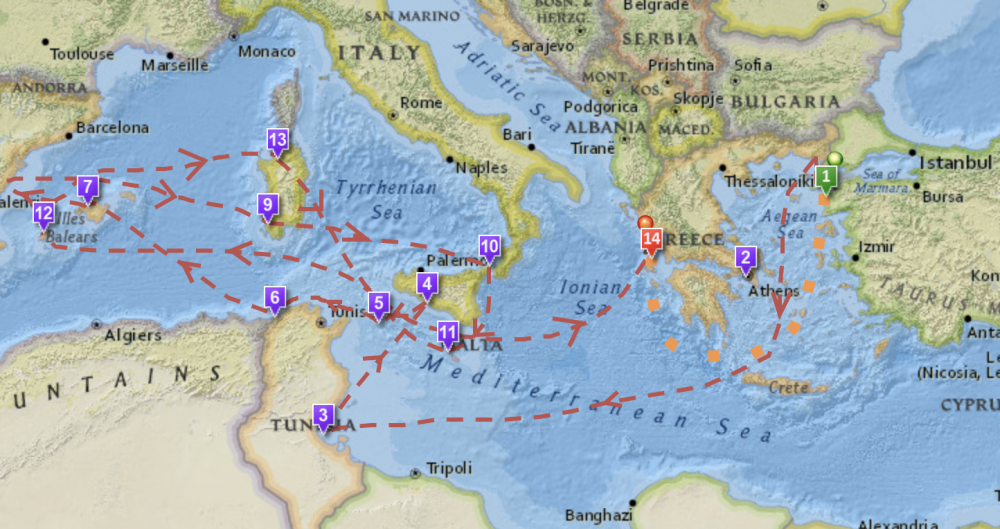
The Odyssey, one of Homer’s two great epics, narrates Odysseus’ long, strange trip home after the Trojan war. During their ten-year journey, Odysseus and his men had to overcome divine and natural forces, from battering storms and winds to difficult encounters with the Cyclops Polyphemus, the cannibalistic Laestrygones, the witch-goddess Circe and the rest. And they took a most circuitous route, bouncing all over the Mediterranean, moving first down to Crete and Tunisia. Next over to Sicily, then off toward Spain, and back to Greece again.
If you’re looking for an easy way to visualize all of the twists and turns in The Odyssey, then we’d recommend spending some time with the interactive map created by Gisèle Mounzer. “Odysseus’ Journey” breaks down Odysseus’ voyage into 14 key scenes and locates them on a modern map designed by Esri, a company that creates GIS mapping software.
Meanwhile, if you’re interested in the whole concept of ancient travel, we’d suggest revisiting one of our previous posts: Play Caesar: Travel Ancient Rome with Stanford’s Interactive Map. It tells you all about ORBIS, a geospatial network model, that lets you simulate journeys in Ancient Roman. You pick the points of origin and destination for a trip, and ORBIS will reconstruct the duration and financial cost of making the ancient journey.
If you would like to sign up for Open Culture’s free email newsletter, please find it here. It’s a great way to see our new posts, all bundled in one email, each day.
If you would like to support the mission of Open Culture, consider making a donation to our site. It’s hard to rely 100% on ads, and your contributions will help us continue providing the best free cultural and educational materials to learners everywhere. You can contribute through PayPal, Patreon, and Venmo (@openculture). Thanks!
Note: An earlier version of this post appeared on our site in December, 2013.
Related Content:
Hear Homer’s Iliad Read in the Original Ancient Greek
What Ancient Greek Music Sounded Like: Hear a Reconstruction That is ‘100% Accurate’
Learning Ancient History for Free


The name of the country north of Macedonia (i.e. the region of Greece) is North Macedonia (Severna Makedonija). Please, change your map according to the international agreements.
Not to worry…Macedonia is north of Greece..so is west,east,north and south Macedonia.
No need to change any maps at this time as this fictitious country will self-destruct and cease toexist in a very short time except as absorbed by its surrounding counties.
Circe’s location is usually thought to be Mount Circeo, south of Rome…never heard of it been identified with the Baleares
I couldn’t get the map to load. It said it had a fatal error. :-(
Same problem for me
The link appears broken, map fails with “Fatal error”, bit like in a Greek tragedy ..
I also got a fatal error. Is the map possibly restricted in which countries it can be viewed?
erm what the sigma
umm what the sigma
Urm what the sigma
nice guys always finished last shouldve known that gave you my hear and you f around and broke that. so sad. girl yu played me did me so shady come on now let me be ruthless
Erm what the sigma ohio. I like gooning and munting. I am the rizzler, I would love to meet the ultimate skibbidi. He is my idol. I hope baby gronk breaks up with livy dunne so i can mog all of them. I love kai cenats big toe.